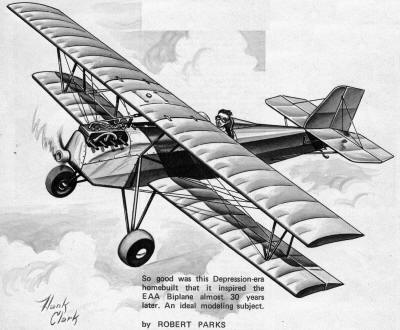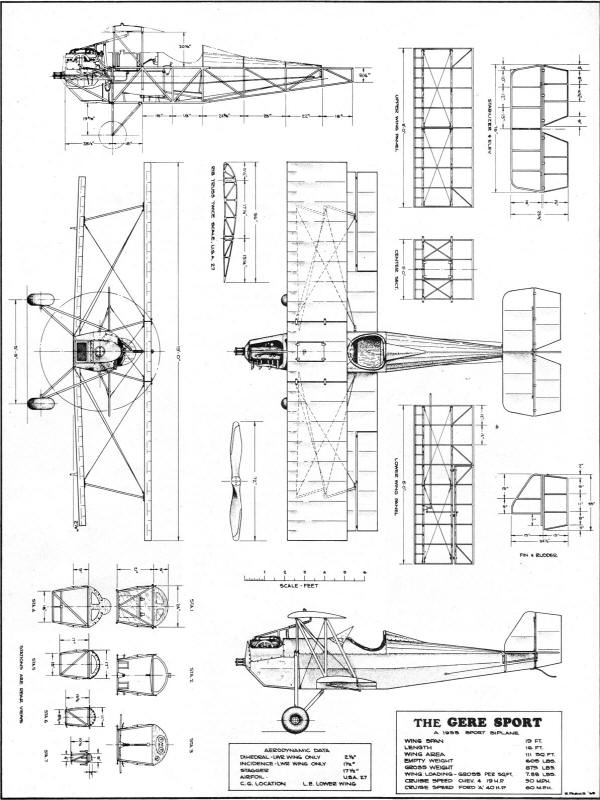|
Here is a nice set of drawings for building a scale model of the
Gere Sport biplane. The tail surfaces are large so that it would
probably not be necessary to enlarge them as is often necessary
for rubber powered models. The Gere Sport, with a wingspan of only
19 feet, was originally designed by 19-year-old Bud Gere (one foot
per year, I suppose). An R/C version of the
Gere Sport with a 36" wingspan was published in R/C Modeler
in 1976.
The Gere Sport
So good was this Depression-era homebuilt that it inspired the
EAA Biplane almost 30 years later. An ideal modeling subject.
By Robert Parks
 One
of the nicest-looking homebuilt biplanes, the Gere Sport never reached
the level of popularity which the Heath Parasol and Pietenpol Aircamper
enjoyed. Nevertheless, it was well-designed for cheap, simple construction
and for good flying characteristics. One
of the nicest-looking homebuilt biplanes, the Gere Sport never reached
the level of popularity which the Heath Parasol and Pietenpol Aircamper
enjoyed. Nevertheless, it was well-designed for cheap, simple construction
and for good flying characteristics.
The original Gere was a Depression baby, born in the days of
muslin covering and worn out auto engines. Its engineering was good
in all respects except one: the powerplant, a four-cylinder overhead
valve Chevrolet engine of 1927 vintage. As a result, the Gere wasn't
a world-beater, but it did fly fairly well. What the engine lacked
in power was made up for by a good airplane. So good was the basic
design that, thirty years later, it was modernized and appeared
as the EAA Biplane.
Designer of the original plane was a 19-year-old youth named
Bud Gere, who never saw his plane fly. He was killed while experimenting
with a powered iceboat. If this little biplane is any example of
his engineering talents, his contributions to aviation would have
been great.
The Sport has all the things that a good biplane should have:
a fairly high aspect ratio, good gap-chord ratio, ample tail surfaces
and ailerons, and a clean, straightforward structure. Of interest
is the use of low pressure tires instead of the hard variety commonly
used by the early homebuilders. Bud Gere took advantage of the Goodyear
Corporation's development of soft, fat tires, which eliminated the
need for shock-absorbing devices on the gear, a la Flybaby.
The entire airplane is a collection of straight tubes and sticks,
which made construction simple and inexpensive for the Depression-style
builder. It is strong for its size, with large-diameter tubing welded
in the right places. The butt-welded wing-to-body fittings, however,
are not in vogue today.
Welds loaded in tension can give up at the most embarrassing
and disastrous times, especially when the ship is airborne.
The wings look as though they came from a beginner's stick model.
All ribs are equally spaced at 12 inches and the tips just "happen"
at the last .rib, which is covered with plywood. The USA 27 airfoil
was quite popular at the time the ship was designed and is as well-suited
for the Gere as it was for many other aircraft of the period. On
the structural side, the unrouted spruce spars were extremely heavy
for a little bird like this and easily could have been replaced
by 3/4-inch stock.
The drawings depict the design exactly as Bud Gere executed it
in 1933, except for the inclusion of Ford Model A power. He recognized
the overweight, underpowered condition of the Chevy 4 and recommended
that Pietenpol's Model A installation be substituted to increase
performance. So, a Pietenpol-style Model A Ford engine, instead
of the Chevrolet, is shown hooked up to the Gere's radiator system.
Except for a few details that need updating, the Gere Sport with
the Ford up front would be a great little homebuilt to buzz around
in today. But the model builder won't have to change a thing in
the planform to build a nice scale RC or free flight. Only the short
nose would need some added weight.

Gere Sport Biplane Plans
Notice:
The AMA Plans Service offers a
full-size version of many of the plans show here at a very reasonable cost. They
will scale the plans any size for you. It is always best to buy printed plans because
my scanner versions often have distortions that can cause parts to fit poorly. Purchasing
plans also help to support the operation of the
Academy of Model Aeronautics - the #1
advocate for model aviation throughout the world. If the AMA no longer has this
plan on file, I will be glad to send you my higher resolution version.
Try my Scale Calculator for
Model Airplane Plans.
Posted
|